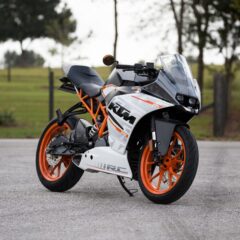
7 Top Motorcycle Accessories
With Christmas just around the corner, you might be wondering what to get your favourite motorcycle enthusiast or even a little something for yoursel...
 Phoenix Motorcycle Training LTD
Phoenix Motorcycle Training LTD
 Phoenix Motorcycle Training LTD
Phoenix Motorcycle Training LTD

Riding a motorcycle is fun. Some even think motorcycle riding with a passenger doubles the fun! But before you go and grab a mate for a ride, there are a few things you should know.
Not all pillion passengers are the same. And having the extra load of another person on your motorcycle will change the performance of your machine. It should also change your riding style. You’ll need to consider the passenger’s experience, comfort and ability when you invite them for a ride. Plus, you’ll need to be doubly conscious of the ‘road conversation’ you have with other traffic.
Read on for our top three tips for motorcycle riding with a passenger — no matter how big or small that passenger might be!
Some people think their motorcycle is more stable with a passenger on the back. Others disagree. Regardless of who’s right or wrong, it’s a fact that the extra weight of another human will affect your motorcycle’s performance.
The higher total weight on the motorcycle changes the centre of gravity, and balance point, and creates a larger mass to slow down. There’s also the increased stress on your shock absorbers.
Because of these changes, where and how your pillion sits on your motorcycle is important. Equally important is how they behave when you are in motion. Your passenger should sit close to you. They need to follow your movements and squeeze firmly with their thighs to anchor themselves firmly to the motorbike. This minimises the impact the extra passenger has on your bike’s performance and improves the safety and comfort of your pillion.
It helps to remember that you have spent hours learning how to ride a motorcycle safely. Your passenger may not have this knowledge and their comfort level on two wheels is likely to be different from your own. You, the rider, should also make an effort to ride as smoothly as possible. Smoothly accelerating, braking and changing gears will stop your helmets from banging together too!
Only fully licenced riders are allowed to take passengers on their motorcycles. If you have a CBT licence, you’re only allowed to ride on your own. If you take pillion passengers, you could be fined and points added to your licence.
Once you move up to an AM licence or higher, motorcycle riding with a passenger is allowed. We’d recommend taking a short course to learn how to ride with a passenger. This means you’ll have the knowledge and experience needed to take someone on the back of your motorcycle safely.
If you’ve never had anyone on the back of your motorcycle before, choosing an experienced rider as your first passenger is a great idea. An experienced motorcyclist will understand how to sit on your bike, how to lean into turns and how to anchor themselves correctly.
If it’s not possible to take another motorcyclist as your first pillion passenger, be prepared to teach an inexperienced person how to be a passenger on a motorcycle. Give them proper instructions on where to sit, how to hold on and how to follow your movements without disrupting your steering or control of the motorcycle.
It’s not enough to tell your motorcycle passenger to sit on the back of your bike as close as they can and just hold on. More information is needed. Start with the basics of getting on and off the motorcycle. You should always get on the motorcycle before your passenger and be the last to dismount.
Go on to explain that they’ll need to squeeze the motorcycle with their thighs and anchor their feet to the pegs. Let them know they need to follow your movements as you ride. The last thing you need is for them to try counterbalancing your movements by leaning in the opposite direction when you take a turn. Nor do you want them stretching tired legs as you enter a turn!
Your passenger needs to be attentive and active on the back of your motorcycle, effectively helping you to ride smoothly and safely. You should also ride in a way that makes them feel safe and comfortable. A good trick is to have them look over your left shoulder when turning left, and right shoulder when turning right.
Even if you have some sort of intercom system between helmets, it’s a good idea to agree on hand signals and movements that will let your passenger know what you are doing. Something as simple as a soft tap on the leg can help your passenger prepare for a burst of acceleration.
Equally, your passenger should have a few signals they can give to you to let you know if they need to move, stop or stretch. Predictable behaviour from both the rider and the passenger will allow for a safer and more enjoyable ride for both.
It is legal to have a passenger on your motorcycle in the UK once you have a full or restricted motorcycle licence. Compulsory basic certificates, or DL196 papers, do not allow riders to carry passengers on their motorcycles or mopeds. CBT riders must ride alone.
UK motorcyclists with AM or higher level motorcycle licences are able to take passengers. It is advisable to practice carrying experienced pillion passengers before carrying an inexperienced passenger. This will help you to understand how the performance of your motorcycle changes with the additional weight.
The difficulty of motorcycle riding with a passenger depends very much on the rider’s and the passenger’s experience with motorcycles. As with any new skill, it takes time to master carrying a passenger on your motorcycle. A short course on carrying pillion passengers is a good start. It’s also wise to practice with another motorcyclist first, if you can, to get a feel for the changes to your motorcycle or moped that carrying another person creates. Get in touch if you’d like to train for carrying pillion passengers on your motorcycle or moped with us!

With Christmas just around the corner, you might be wondering what to get your favourite motorcycle enthusiast or even a little something for yoursel...

If you love motorcycle riding, you’ve probably daydreamed about riding a motorbike for a living. A professional racer or stunt rider is OK for some...

Getting a UK motorcycle licence can seem a complicated process. Particularly when compared to a driving licence for a car. Whether you choose the pro...
This website uses cookies to personalise content, ads, and analyse traffic, sharing data with partners who may combine it with other information. See our Privacy Policy for more information.